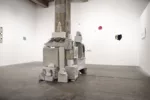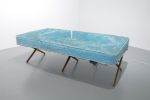
Detail of Mark Fox’s explosion of pop culture information and signage
There’s a lot to look at out in the world–golden arches, illuminated Meineke Muffler logos, and the mesmerizing bullseye imagery in the Target commercials. So people who make works on paper have some heavy competing to do, and clearly they realize it, because the Contemporary Works on Paper show at the Philadelphia Museum of Art includes lots of works of ambitious, look-at-me scale.
Not only do they have to compete in the hyper-commercialized and high-speed computerized visual landscapes in which we live, but they also have to compete for attention with the little bits of nature that still peek through the visual noise and are the reality behind the daily reality of a pampered life in houses with hot and cold. Those little bits of nature represent the planet and the universe beyond, the natural world that’s keeping us alive.
It’s that engagement with the concept of man’s place in nature and what nature means that gives the first half of this exhibit its juice, and how juicy it is at times!
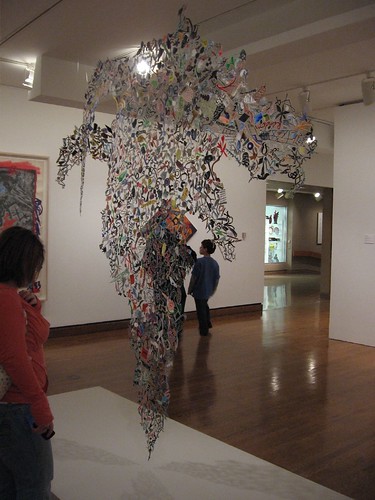
Untitled (End of Days), by Mark Fox
The show-stopper was Mark Fox’s explosive Untitled (End of Days), a network of pop-culture trivia exploded into a mushroom cloud. Its delicacy suggests a world barely holding together as cultural artifacts spiral out of control. It also looks great from the back, where it becomes a randomized doily of white paper that kind of looks like a map of Africa.
{At a recent event of art friends, we all wanted to know how in heck the museum stored the thing. PMA Assistant Curator of Prints and Drawings at the Philadelphia Museum of Art Shelley Langdale acted like it was not big deal, and said they rolled it up with paper between to keep it from catching on itself}.
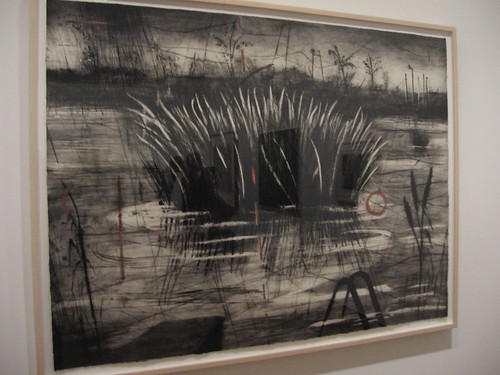
Reeds, by William Kentridge, 1996, etching, aquatint and drypoint
It was the map-like shape that started me thinking these thoughts, that were then reinforced by the juxtaposition of William Kentridge’s Reeds, with its marks suggestion human presence and orientation superimposed on a landscape, next to Richard Long’s Dorset Song Lines, a sort of altitude map of several days’ march. I loved Kentridge’s mappy notations mixed with the landscape’s up-close tactile sense–right next to the rather impersonal looking Song Lines. They both had very much the same message about our relationship to the natural world.
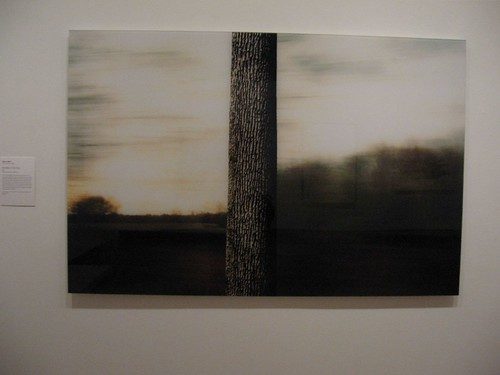
From there it was a short leap to giant ultra close-ups of leaves and pods, and from there an even shorter leap to the concept of reinventing the land altogether, ideas behind Peter Campus’ faux bush, burning, a computer-generated image made up of multiples of just a few basic marks. A similarly man-manufactured image from Peter Hutchinson, Berlin-Mexico, included images collaged from two different locales to create a weird new landscape of his imagination. And next came local photographer Eileen Neff’s trick landscape that almost looks real and right but is totally wrong, totally manufactured, a closeup tree appearing to bisect what is in fact not one space but two. Another notable piece on the relationship of humans to the land around them include Roni Horn’s triptych, footnoted views of the River Thames.
The exhibit has a number of local artists besides Neff, including Susan Abrams, Neysa Grassi, and from Philadelphia Print Collective portfolios, Isaac Lin, Charles Burwell, Shelley Spector, Kate Abercrombie and Candy DePew.
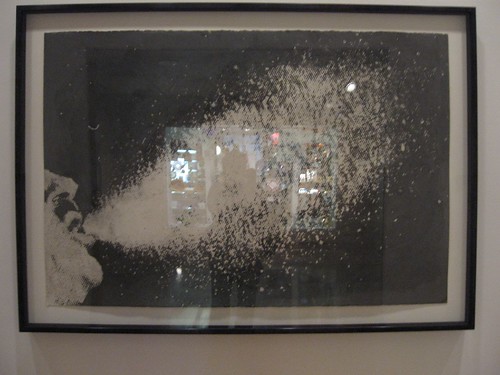
Sneeze, by Heide Fasnacht, graphite on watercolor paper
The second half of the exhibit doesn’t carry through on the subject, except here and there, and was mostly organized around similiar issues in close proximity. Among my favorites were Heide Fasnacht’s giant Sneeze with its faux Benday dot efflourescence and Javier Vallhonrat giant closeup of a melting ice cube, from his Precarious Objects series. In the small-scale category, I loved Dove Bradshaw’s Untitled (Grass) carbon-paper rubbing, and Hong Hao’s New World Map (Selected Scriptures, Page 3535). More images here.


